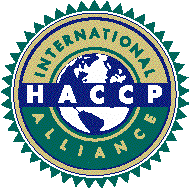
Option One:
Virtual Live with Alex using Zoom
Available Now
2021 Classes
Virtual Live PDT May 10 and 11,2021
Virtual Live PDT June 1 and 2, 2021
Virtual Live PDT July 6 and 7, 2021
Virtual Live PDT August 9 and 10, 2021
Virtual Live PDT September 13 and 14, 2021
Virtual Live PDT October 11 and 12, 2021
Virtual Live PST November 8 and 9, 2021
Virtual Live PST December 6 and 7, 2021
Development and Implementation of HACCP for Food Processors and Food Related Industries
Introduction
History
Prerequisite Programs
Good Agricultural Practices
Good Manufacturing Practices
Other Prerequisite Programs
Five Preliminary Steps:
1. Assemble the HACCP Team
2. Describe the Food and Its Distribution
3. Describe the Intended use and the Consumers of the Food
4. Develop a Flow Diagram which describes the Process
5. Verify the Flow Diagram
Seven Principles of HACCP
1. Conduct a Hazard Analysis
2. Determine the Critical Control Points (CCPs)
3. Establish Critical Limits
4. Establish Monitoring Procedures
5. Establish Corrective Actions
6. Establish Verification Procedures
7. Establish Record-Keeping and Documentation Procedures
Appendices:
– National Advisory Committee on Microbiological
Criteria for Foods (NACMCF)
– 21 CFR 117 Subpart B: Current Good
Manufacturing Practices, Hazard Analysis, and
Risk-Based Preventive Controls for Human
Food
– Blank Forms
– Hazard Analysis and Risk Assessment

Option two:
Self-Paced –
60 Days
Coming Soon
This option would be self-paced to be finished within 60 days. Alex is available to answer questions. The course will be very interactive and multimedia is used.
The manual and the Exercise Workbook will be shipped free of charge.
Development and Implementation of HACCP for Food Processors and Food Related Industries
-Introduction
-History
-Prerequisite Programs
-Good Agricultural Practices
-Good Manufacturing Practices
-Other Prerequisite Programs
Five Preliminary Steps:
1. Assemble the HACCP Team
2. Describe the Food and Its Distribution
3. Describe the Intended use and the Consumers of the Food
4. Develop a Flow Diagram which describes the Process
5. Verify the Flow Diagram
Seven Principles of HACCP
1. Conduct a Hazard Analysis
2. Determine the Critical Control Points (CCPs)
3. Establish Critical Limits
4. Establish Monitoring Procedures
5. Establish Corrective Actions
6. Establish Verification Procedures
7. Establish Record-Keeping and Documentation Procedures
Appendices:
– National Advisory Committee on Microbiological Criteria for Foods (NACMCF)
– 21 CFR 117 Subpart B: Current Good Manufacturing Practices,
-Hazard Analysis, and Risk-Based Preventive Controls for Human Food
– Blank Forms
– Hazard Analysis and Risk Assessment

Option Three:
Onsite Classes
When it is Allowed
Los Angeles, CA June 14 and 15, 2021
Chicago, IL August 16 and 17, 202
Chicago, IL October 4 and 5, 2021
Los Angeles, CA November 1 and 2,2021
Chicago, IL November 29 and 30, 2021
Holiday Inn Express and Suites
125 Pacific Coast Highway
Hermosa Beach, CA 90254
Development and Implementation of HACCP for Food Processors and Food Related Industries
Introduction
History
Prerequisite Programs
Good Agricultural Practices
Good Manufacturing Practices
Other Prerequisite Programs
Five Preliminary Steps:
1. Assemble the HACCP Team
2. Describe the Food and Its Distribution
3. Describe the Intended use and the Consumers of the Food
4. Develop a Flow Diagram which describes the Process
5. Verify the Flow Diagram
Seven Principles of HACCP
1. Conduct a Hazard Analysis
2. Determine the Critical Control Points (CCPs)
3. Establish Critical Limits
4. Establish Monitoring Procedures
5. Establish Corrective Actions
6. Establish Verification Procedures
7. Establish Record-Keeping and Documentation Procedures
Appendices:
– National Advisory Committee on Microbiological Criteria for Foods (NACMCF)
– 21 CFR 117 Subpart B: Current Good Manufacturing Practices, Hazard Analysis, and Risk-Based Preventive Controls for Human Food
– Blank Forms
– Hazard Analysis and Risk Assessment

